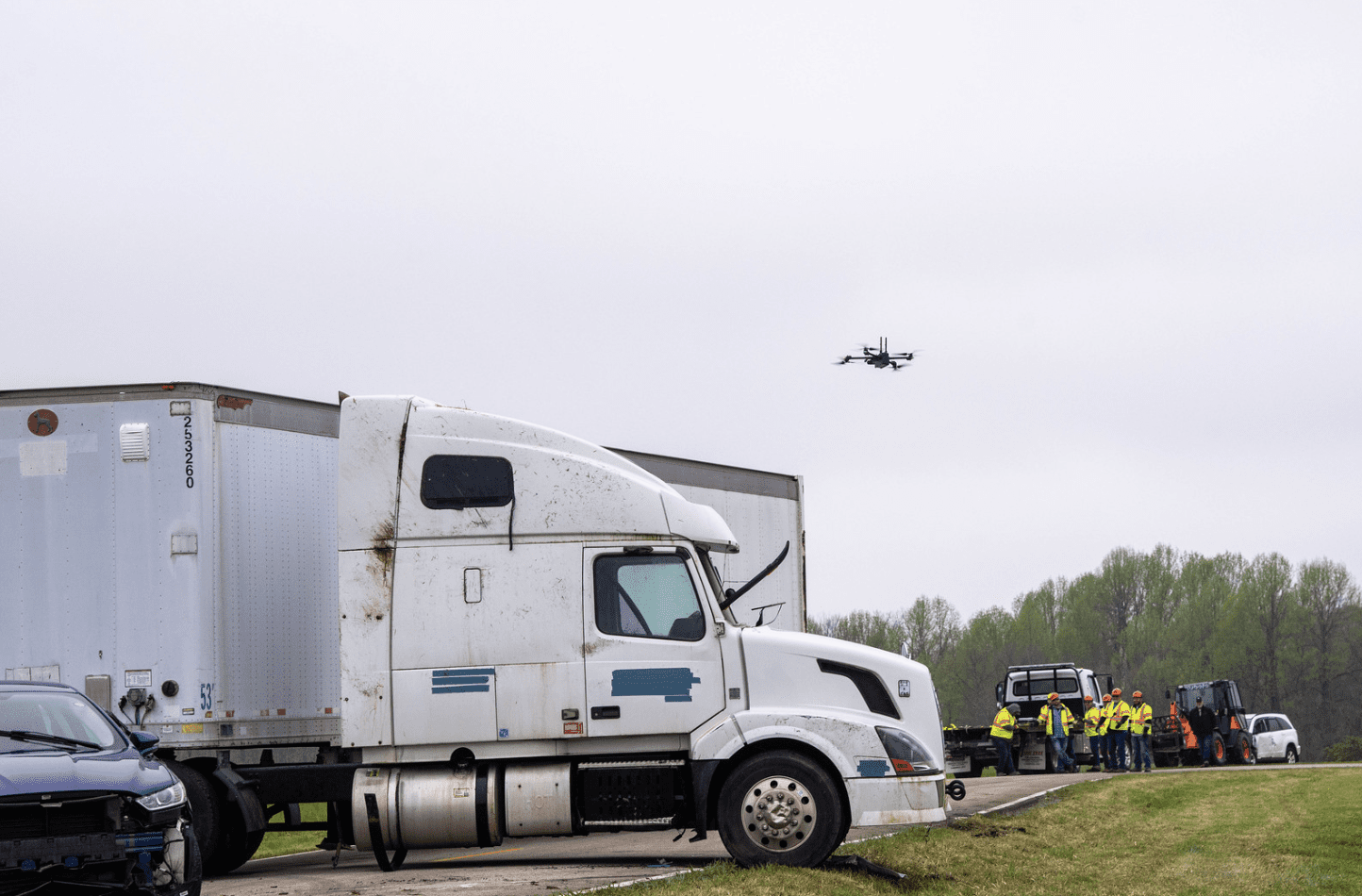
Ohio Uses Drones for Crash Scene Exercise
By John MacAdam
Photo/Video Credit: This multi-agency exercise was staged and filmed at the Transportation Research Center, Inc. in The Beta District. Footage courtesy of ODOT.
The Ohio Department of Transportation and partners staged a first-ever vehicle crash scene response and research exercise using drones.
Traffic crash scenes are, unfortunately, all too common. A semi rolled over on its side. Multiple wrecked cars. A line of traffic forming behind the crash. First responders rushing to secure the scene. This exact crash scene took place recently in East Liberty, Ohio. Only this time, the entire crash was staged. The Transportation Research Center Inc. hosted a full-scale, first-of-its-kind traffic incident management training exercise. It included a multi-disciplinary group of first responders and researchers – and automated eyes in the sky.
Safe and quick clearance of a crash scene takes coordination, communication and a lot of specialized equipment. The training included patrol vehicles, heavy towing equipment, a medical helicopter, full-sized fire trucks, and a group of volunteers willingly sitting in a traffic queue. But the smallest technology took center stage: drones. Specifically, uncrewed aircraft systems (UAS).
Continued Advancements in Drone Technology
Situational awareness during incident management saves time; saved time can literally save lives. After confirming the airspace was clear, operators flew the drone above the crash site to transmit live aerial footage to the ODOT Traffic Management Center. Drones also captured high resolution pictures to support crash investigations after the scene was clear. In a real-world situation, this prevents delays in re-opening the roadway.
This is the first live, full-scale traffic crash scene exercise in the nation to involve UAS coordination, an advanced aerospace research team and first responders. Earlier, more limited exercises also showed how drones can assist. A 2018 test with drones by the Washington State Police showed a 60% - 80% reduction in crash reconstruction times. The Ohio Attorney General's office also studied the use of drones for crash reconstruction in 2019. "This is an absolutely critical enabling technology to keep the flying public safe," said Matt McCrink, PhD, lead scientist for The Ohio State University’s research team.
In 2018 the Ohio UAS Center formed a strategic drone research partnership with DriveOhio, ODOT’s smart mobility arm, to develop an uncrewed traffic management (UTM) system. "[UTM] gives drones an understanding of where they are in the airspace, who’s around them, and what they can do to safely navigate from A to B," McCrink said.
So, when the medical helicopter was called to the scene, the UTM system alerted other drone operators to clear the airspace.
Drone Research Within Central Ohio
The Beta District is uniquely positioned for this type of research. The Smart 33 Mobility Corridor has capacity for the ground-based radar systems necessary to support drone traffic. "Ohio is right at the tip of the spear," said Richard Fox, airspace manager for the Ohio UAS Center. "We're working with the FAA to certify this infrastructure being deployed on this corridor."
Critical to adopting new technology is collaboration. The Beta District has an incredibly engaged community and collaboration during this event was impressive. Participants included:
- The Transportation Research Center
- The Ohio State University Aerospace Research Center
- The Ohio State Highway Patrol
- Ohio Department of Transportation and Traffic Management Center
- DriveOhio, FlyOhio and the Ohio UAS Center
- Emergency responders
- The Antrim Volunteer Fire Department
- Multiple private towing companies
"We see a lot of organizations and companies gravitating towards Ohio because they know we have very representative systems and procedures in place where they can test out their equipment, products and operations in a relevant environment," said Sean Calhoun, of CAL Analytics, who attended the exercise. "What sets Ohio apart is their focus on a systematic approach to building a foundation for the industry and the technology. You've seen some states do demonstrations, but Ohio has taken an approach to really laying down the foundation for letting the industry grow."
Ohio Governor Mike DeWine captures best what this means for the Beta District:
"The future is now, and this is just the latest chapter in Ohio’s storied history of pioneering flight technology. We have the ability, the knowledge, and the resources to be the top destination for this industry to thrive."
About John MacAdam
John MacAdam, PE, a nationally recognized transportation professional, previously led ODOT's award- winning Transportation Systems Management and Operations (TSMO) Program. As a leader of advanced mobility teams for more than 16 years, John helps organizations understand and deliver technology solutions.
To learn more, follow The Beta District on LinkedIn or contact us today.

